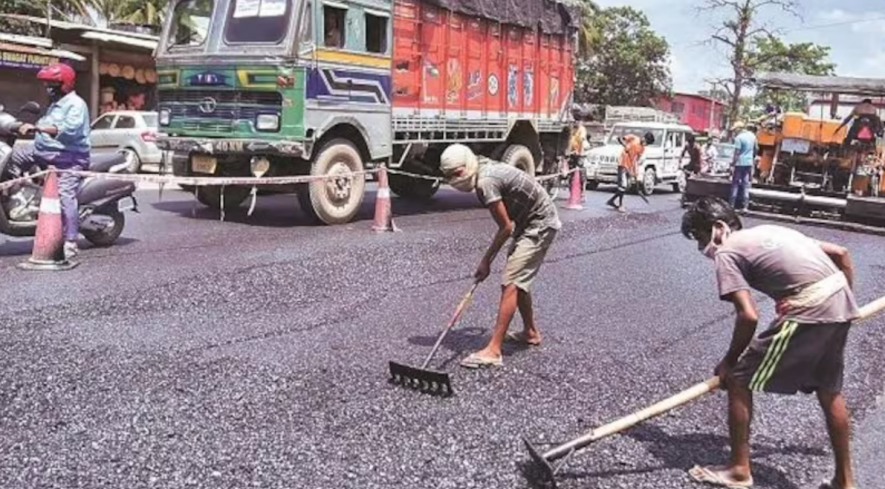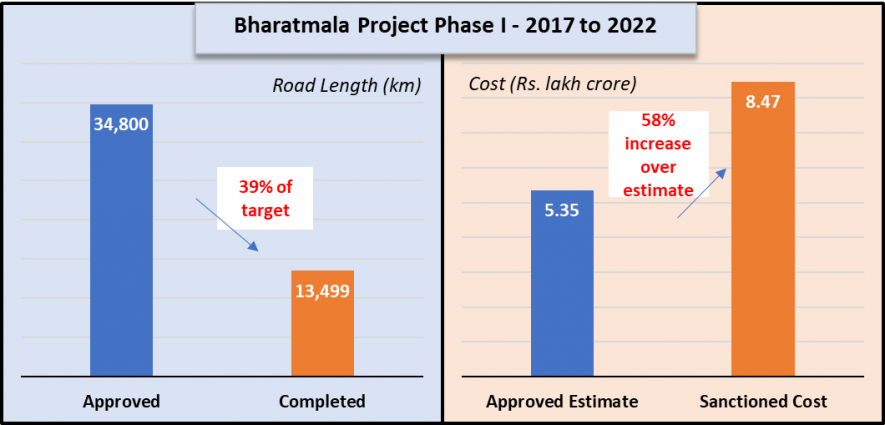Highways or Rural Roads, It’s a Story of High Cost-Low Delivery

Image for representational purpose. Credit: Business Standard
The NDA government led by Prime Minister Modi has repeatedly emphasised its commitment to building the country’s infrastructure like roads, bridges, railway lines, etc. Periodically, the Prime Minister is seen inaugurating an expressway here, a bridge there. Announcements of massive construction projects keep happening, especially around election time. But two recent reports reveal a picture of missed targets, huge cost escalation, misconceived plans and a sense of disarray that is quite contrary to the impression that the government is efficiently going about creating essential infrastructure for the country.
One is the recently released performance report by the Comptroller and Auditor General of India (CAG) on the central government’s Bharatmala project which was to build nearly 35,000 kilometres of economic corridors, national highways, border roads, coastal highways, and connected feeder roads network between 2017 and 2022. The other is a report by the Parliamentary Standing Committee on Rural Development and Panchayati Raj on the Pradhan Mantri Gram Sadak Yojana (PMGSY), which is a programme to build rural roads connecting habitations and essential services. Undoubtedly, both types of roads are essential for economic development as well as for improving the quality of life of people. But their fate – as revealed by these official reports – is uninspiring if not distressing. Let’s have a look.
Highways to Nowhere?
The CAG report (No.19 of 2023) says that the target for Phase I of the Bharatmala project was construction of 34,800 kms of roads. This was approved by the Cabinet Committee on Economic Affairs (CCEA), chaired by the Prime Minister and consisting of top ranked Cabinet ministers. The approved estimated cost was pegged at Rs 5.35 lakh crore. But, as of March 2023, only 26,316 kms of highway length was actually awarded and of that, only 13,499 kms have been completed. That’s just 38.79% of the original CCEA target. (See chart below)

That’s not all. The CAG also points out that over Rs 8.47 lakh crore has already been sanctioned. (See above) That’s a jaw dropping 58% cost over-run. To put it differently, the cost was originally envisaged as Rs 15.37 crore per kilometre but it has now risen to Rs 32.17 crore per kilometre.
It is clear that the whole project is seriously lagging behind. It was to have been completed by September 2022 but six months after that, it is reported to be just 40% complete, with a massive cost overrun already there.
Some idea of why this may have happened can be gleaned from various comments made by CAG. For those interested, the detailed report may be studied at the CAG website. Here are some salient points, that make for worrying reading, and raise questions about the great efficiency of which this government often boasts about:
- Projects which were earlier stuck due to forest clearances or right of way disputes were again included in the Bharatmala project without resolving the issues.
- Much chopping and changing took place during an optimisation exercise with road lengths being added and shifted around. The CAG chided the ministry of road transport and highways that “MoRTH may carry out an in depth analysis based on accurate ground level data before proposing a scheme of this magnitude in future”.
- The National Highway Authority of India (NHAI) prioritised the work without any “rational, systematic and codified methodology”. No timelines were decided for awarding and constructing the projects falling under different priorities. In some cases, projects were developed based on a “deficient cost-benefit study” or “without getting detailed project reports prepared”.
- Costs have gone up because of “significant changes” in the scope of projects, cost estimates and “richer project specifications”. Another reason was that the expected private sector participation did not materialise.
- Appraisal and approval mechanism for award of projects had many deficiencies leading to some major projects (like Delhi-Vadodara Expressway) not being assessed by CCEA or MoRTH. In some cases, the laid down mechanism was not even followed.
- Competent Authority did not evaluate Detailed Project Reports in many cases. Instances of irregularities in award of projects by implementing agencies were observed in clear violation of the prescribed processes of tendering,
- Many projects were started without environmental clearances.
Importantly, CAG observed that there was no “target for the achievement of measurable outcome parameters such as accident reduction, comfort in riding and user satisfaction, etc.” Resultantly, the benefits of the development of BPP-I projects and scheme as against these outcome parameters, could not be verified, the report said.
In short, it is a costly mess of gigantic proportions but still, it is being portrayed as a big achievement by the spin-masters of the government.
Rural Roads Scheme Flounders
Now let us turn to the other end of the spectrum – the small rural roads, mostly of 3 kms or more. This is a programme launched way back in the year 2000 during the first NDA government led by Prime Minister Atal Bihari Vajpayee. Since inception till October 25, 2022, Rs 2,87,798 crore have been spent towards the construction of rural roads under PMGSY. This includes state government contributions, which were introduced in 2015-16 by the new Modi government. Under Phase I, over 6.45 lakh kilometres were to be built connecting 1.57 lakh habitations, as identified on the basis of the 2001 Census. As of October 2022, 6.21 lakh kms have been constructed. Under Phase II of the programme launched in 2013, 50,000 kms were to be built to consolidate the existing network. Of this, some 48,383 kms have been completed. Under the Modi era, a programme for building roads and bridges called Road Connectivity Programme in Left-wing Extremism Areas (RCPLWEA) was launched in 2016 (with additions later) to build 12,076 km of road length out of which 6,495 km have been completed as of October 2022. And finally, in 2019, PMGSY III was launched which proposed to build 1.25 lakh kms roads to connect habitations to mandis, schools and hospitals, based on usage. This phase is supposed to be completed in March 2025.
What’s to be noted is that over two decades since Phase I of the scheme was launched, over 24,000 kms still remain unbuilt, while another 1,600 kms under Phase II launched a decade ago remain unbuilt. The new phases launched under the Modi government too have suffered a similar fate. Over 5,371 kms remain to be built under the RCPLWEA although its target date for completion was March 2023. While the Phase III completion target is March 2025, as of January 2023, some 75,717 remain to be built. These shortfalls are derived from data recorded in the Standing Committee Report.
The Standing Committee was told by the Rural Development ministry that Phase III projects are not being sanctioned for those states which have not yet completed their Phase I and II work. The net result is that the whole thing is delayed. Another factor has been the shift from a fully Central funded scheme to a shared funding system where the Centre-State fund sharing is on 60:40 basis, except in hilly states where it is 90:10. Given the dire situation of State Government finances, especially after the pandemic, this has further decelerated the scheme implementation.
But, as the Standing Committee pointed out, the biggest shortcoming is that population and habitation counts are based on 2001 Census which was 22 years ago. Between 2001 and 20011, India’s average population increased at 17.7%. If one assumes a similar growth rate for the 2011-21 decade, population would be at least 30% higher than in 2001. So, the number of habitations needing roads would be much more than the targets. The ministry told the Committee that the issue was raised with the Finance Ministry but they turned down the proposal arguing that funds were short.
Thus, in the case of rural roads, the situation is again a mess – but for different reasons. There is no will to spend more money for building these rural roads.
The great infrastructure creation drive launched by the present government appears to be floundering in different ways and for diverse reasons – at least in the case of road building.
Get the latest reports & analysis with people's perspective on Protests, movements & deep analytical videos, discussions of the current affairs in your Telegram app. Subscribe to NewsClick's Telegram channel & get Real-Time updates on stories, as they get published on our website.
























